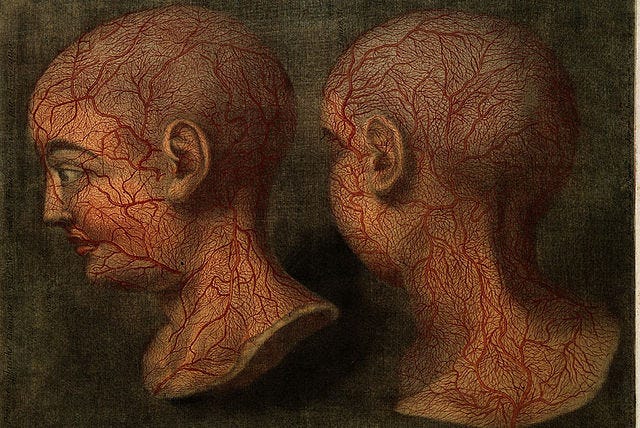Exploring the Interconnection of Vedanta, Fractals, and the Universe
Written on
Vedanta, a key philosophical doctrine in Indian thought, draws from the Upanishads and ancient Hindu scriptures that explore the ultimate reality, the self, and the cosmos. The term "Vedanta" literally means "the end of the Vedas," reflecting the philosophical insights derived from these sacred texts, particularly the Upanishads. This philosophy highlights the unity of all existence, positing that the Self (Atman) is identical to the universe's ultimate reality (Brahman).
The Vedantic concept of "Visvatomukham," meaning "facing all directions," resonates deeply with the principles of fractal geometry, which suggests that the divine essence manifests in every form. This idea mirrors the self-similar patterns observed in fractals, where smaller parts reflect the whole.
The Upanishads convey, “From fullness, fullness comes. When fullness is taken from fullness, fullness remains.” This illustrates that infinity continuously emanates from an eternal source, which is inexhaustible. In mathematics, fractals similarly demonstrate how simple iterations can produce vast complexity, maintaining core patterns in each repetition.
In Vedanta, Brahman is seen as the foundational reality that exists beyond and encompasses the diverse universe. Fractals symbolize the relationship between unity and diversity, revealing how the entirety resides within each component, showcasing the interconnectedness of parts and wholes.
Fractal Dodecahedron
The prevalent cosmological model suggests an infinite, flat universe. Contrarily, some cosmologists propose that the universe resembles a finite, curved dodecahedron—a twelve-sided polygon with pentagonal faces. This dodecahedron acts as a fractal, maintaining consistent shape across various scales.
This hypothesis aims to explain anomalies in observations of the cosmic microwave background (CMB) radiation, the afterglow of the Big Bang, which should be isotropic (uniform) across all directions. Yet, certain findings indicate unexpected large-scale temperature fluctuations that defy the infinite, flat universe model.
The dodecahedral universe theory posits that these discrepancies may arise from a finite and curved cosmic structure, where the CMB appears uniform due to our position near its center. Nevertheless, this theory remains speculative and is not widely accepted among scientists, requiring further data and analysis to validate or refute its claims.

Notable scientists contributing to this theory include: - Jean-Pierre Luminet, a French astrophysicist, who published a paper on the dodecahedral model in 2003. - Glenn Starkman, a professor at Case Western Reserve University, who co-authored a related paper in 2003. - Jeffrey Weeks, an American mathematician, who developed software for visualizing potential cosmic shapes.
# Understanding Fractals
Fractals are mathematical constructs distinguished by self-similarity, where smaller parts replicate the structure of the whole at varying scales. This scale symmetry means that enlarging or reducing sections of a fractal reveals details akin to the entire structure.
While fractals can be artificially generated through algorithms, they also appear frequently in nature due to complex dynamic processes. Here are ten natural examples of fractal patterns:
- Tree Branches: Each branch mirrors the overall shape of the tree, resulting from a process of dichotomous branching.

- River Networks: The paths of rivers and their tributaries create watersheds with fractal characteristics, resembling similar shapes across scales.
- Jagged Coastlines: Viewed from above, coastlines exhibit complex, repeating shapes.
- Cloud Patterns: The turbulent motion of the atmosphere shapes the jagged edges of clouds, which are inherently fractal.
- Snowflakes: Each snowflake displays intricate hexagonal structures that embody self-similarity.
- Coral: The branching structure of coral represents a fractal growth process.

- Romanesco: This vegetable showcases fractal spirals that self-replicate at decreasing scales.
- Spiderwebs: The intricate designs of webs formed by spiders embody fractal patterns.
- Blood Vessels: The branching structure of the cardiovascular system, from arteries to capillaries, exemplifies fractal geometry.

- Bronchial Tree: The airways in the respiratory system also reflect a fractal pattern through dichotomous divisions.
Sarva-gatah
The Vedantic concept of "Sarva-gatah," meaning "all-pervading," alongside the understanding of Brahman as omnipresent, rejects reductionism and dualism. It reveals the inherent unity within diversity. Sarva-gatah signifies the omnipresence of Brahman, the Absolute Reality that permeates the cosmos while transcending it. Fractals, through recursive self-similarity, manifest the interconnection of parts and wholes, echoing how Brahman is fully expressed in every fragment of the universe. Both perspectives challenge conventional logic, presenting profound truths about the complexity of existence.
Translating “Fractal” into Sanskrit
Recently, I explored how the term "fractal," introduced by Benoit Mandelbrot in 1975, could have been rendered using ancient Indo-European linguistic roots, particularly in the Indo-Iranian branch, and subsequently into Sanskrit. This endeavor stemmed from my belief in the fractal essence of Vedantic teachings and my desire to find linguistic parallels.
A possible Sanskrit translation for "fractal" I proposed is:
bhrama-rupa-anubhava-prav?h
The phrase can be interpreted in two ways: - Illusory repeated movement of self-similar forms of unity. - Illusory form-experience-flow of unity.
Exploring the Indo-European roots:
- bhrama (????):
- Syllables: bhra + ma
- Meaning: illusion, error, confusion
- Root: bher, implying "to wander" or "to stray."
- rupa (???):
- Syllables: ru + pa
- Meaning: form, appearance
- Root: reu, signifying "to see" or "to perceive."
- anubhava (?????):
- Syllables: anu + bhav
- Meaning: experience, perception, understanding
- Root: anbheue, meaning "to become aware of."
- prav?h (??????):
- Syllables: pra + v?h
- Meaning: flow, movement
- Root: wegh, indicating "to carry" or "to transport."
Explanation
As stated, fractals embody the paradox of infinity within the finite. They are self-similar forms, where every part mirrors the whole in an endless cycle of reflection.
Initially, "bhrama" represents illusion—a visual trick. Fractals appear to extend infinitely while occupying no actual space, leading observers into a labyrinth of endless shapes and confusion.
Next, "rupa" signifies form. Although fractals continuously change, persistent observation reveals recognizable patterns emerging from chaos. Designs and geometric forms materialize from apparent disorder, challenging logical constraints and revealing beauty from formlessness.
Following this is "anubhava," denoting experience or insight. Delving into the fractal continuum uncovers hidden truths, providing clarity through exploration and observation.
Finally, "prav?h" refers to flow and dynamism. Fractals embody perpetual transformation, giving rise to new possibilities without limitations. Their existence transcends rigidity, allowing evolution to flourish in fractal dimensions.
Amid the interplay of illusion and form, experience and flow, fractal paradoxes arise. Misconceptions yield revelations, and aimlessness aligns with order, filling space with meaning. By pursuing bhrama-rupa-anubhava-prav?h, we reveal insights obscured by superficial perception.
Conclusions and Takeaways
Through abstract geometry or spiritual embodiment, we engage with nature's intricate patterns, touching upon the divine essence that radiates through diversity. This interconnectedness is not fragmented but rather woven into a seamless tapestry—a fractal dodecahedron blooming from the self-similar essence of Sarva-gatah, the omnipresent source.
Both Vedanta and fractal geometry celebrate intuitive understanding over rational analysis. These perspectives unveil truths beyond reductionist interpretations, emphasizing the inherent fullness of reality and the infinite connections among all forms.
Recognizing Viskvatomukham—that divine fullness perceives through every aspect—dissolves the illusion of separation. As the Upanishads state, “When fullness is taken from fullness, fullness remains.” Nothing essential is lost; the illusion of lack is merely a trick of perception.
In summary, Viskvatomukham and fractal cosmology evoke wonder at the hidden splendor of existence, teaching that diversity arises from and returns to a unified essence. All apparent fragmentation is transient. Ultimately, the universe exists as a singular fractal entity, imbued with divine fullness in the present moment.
The connections between Vedanta, fractals, and the dodecahedral universe suggest that unity and diversity emerge from a singular consciousness. The self-replicating patterns in fractals imply an inherent interconnectivity among all forms, potentially arising from and returning to a common source. By awakening to our infinite nature, we can transcend divisions and recognize our shared essence, discovering the unifying thread that integrates multiplicity into a cohesive tapestry, resonating with the one presence that encompasses all—reflected in both sarva-gatah and fractal patterns for those willing to perceive.
Thank you for reading.